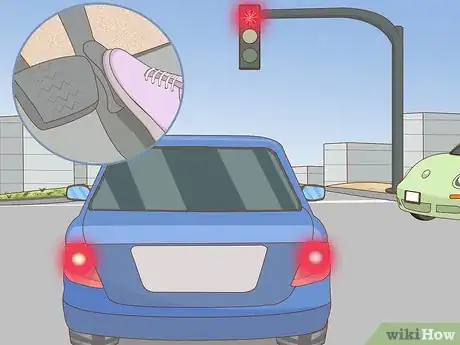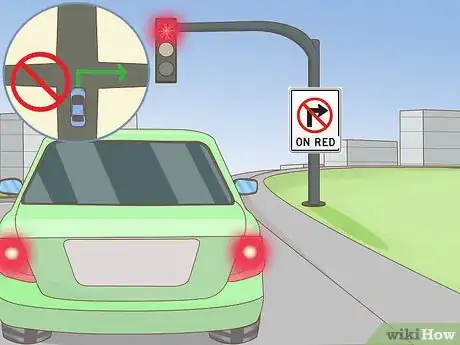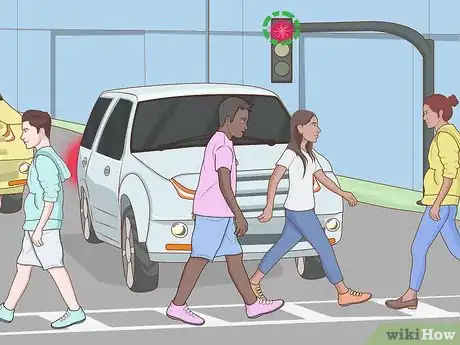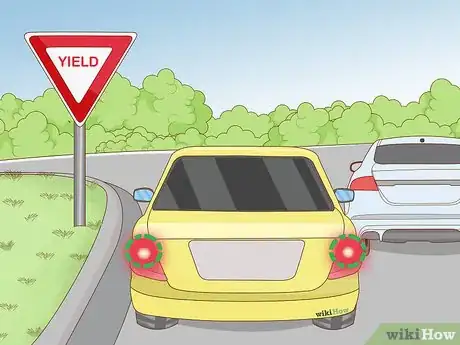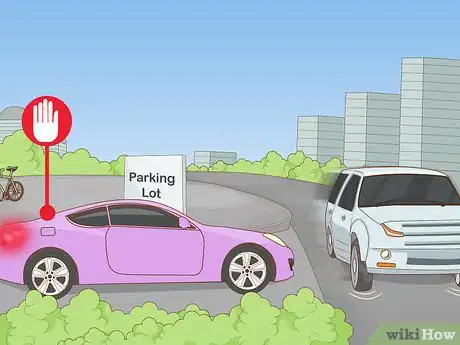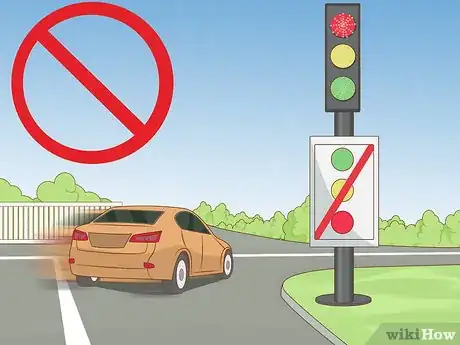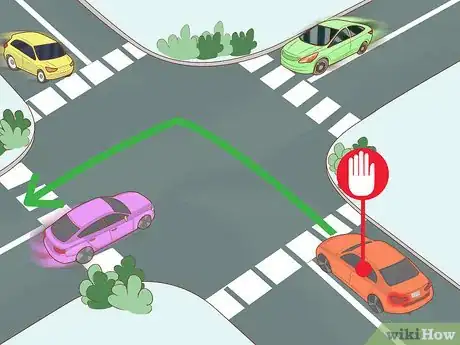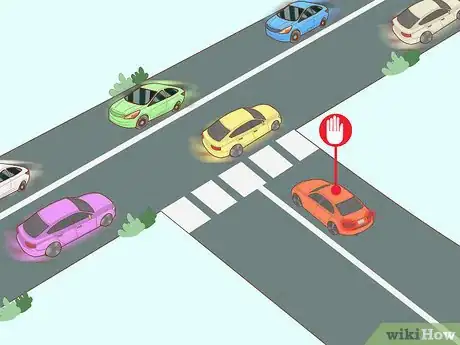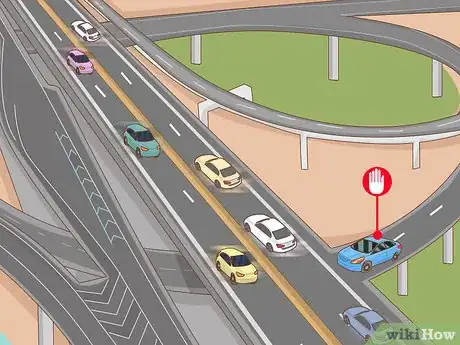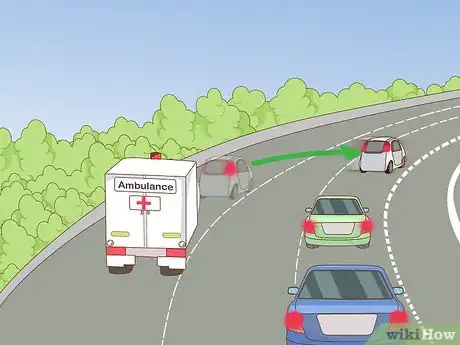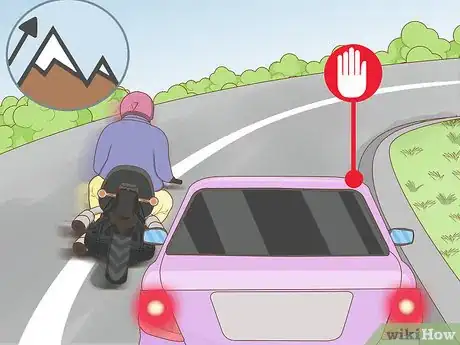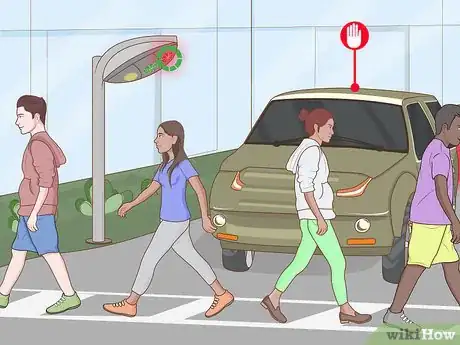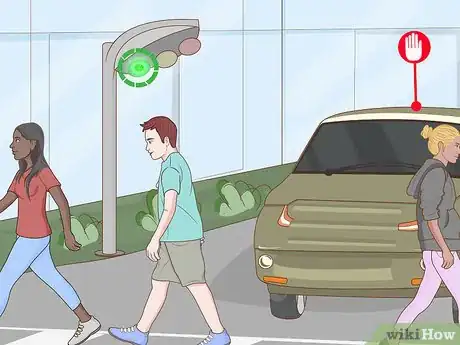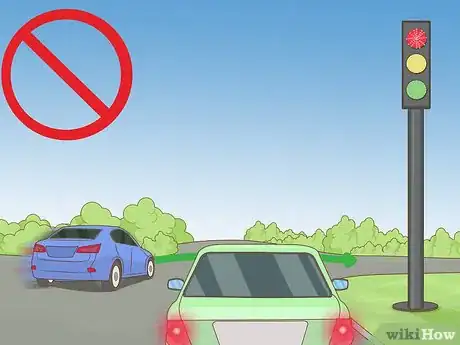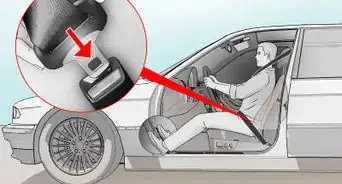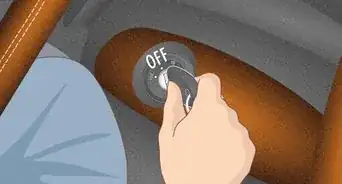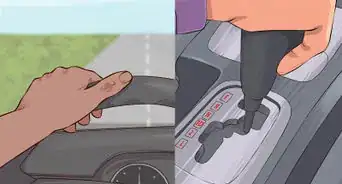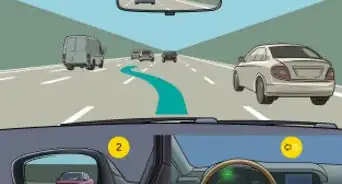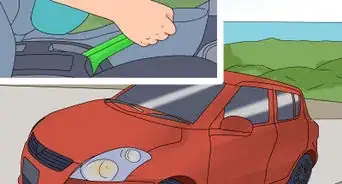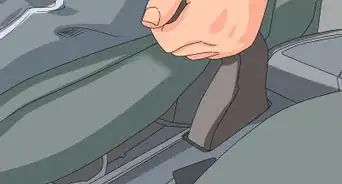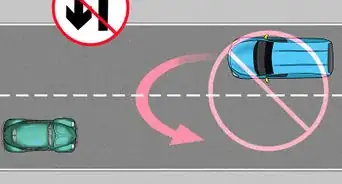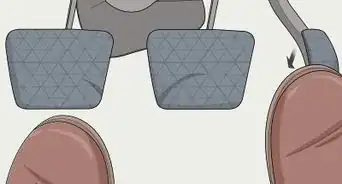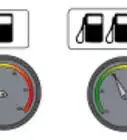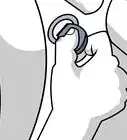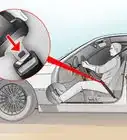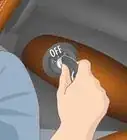This article was co-authored by Simon Miyerov. Simon Miyerov is the President and Driving Instructor for Drive Rite Academy, a driving academy based out of New York City. Simon has over 8 years of driving instruction experience. His mission is to ensure the safety of everyday drivers and continue to make New York a safer and efficient driving environment.
There are 11 references cited in this article, which can be found at the bottom of the page.
This article has been viewed 312,477 times.
Respecting others' rights of way on the road is essential, but the rules can get tricky. General guidelines, such as stopping at a red light or stop sign and yielding to pedestrians, are fairly straightforward. However, you’re bound to encounter unique situations at intersections and while driving on unfamiliar or hazardous roads. To prevent accidents or injuries, exercise due diligence and learn how to handle special circumstances ahead of time.
Steps
Following General Rules
-
1Come to a complete halt at a stop sign or red light. At a stop sign, come to complete halt for about 2 seconds or until vehicles that arrived before you clear the intersection. If you’re stopped at a red light, proceed when the light has turned green. If the intersection has a white stripe in your lane, stop before this line.
- If you have a stop sign, but the street you’re crossing does not have a stop sign, wait until all traffic has cleared before crossing the intersection.[1]
- Before you proceed, be sure all vehicles, bicycles, and pedestrians have cleared your path, even if it’s your turn to go.
- Treat a blinking red light as a stop sign. A blinking yellow light means slow down and proceed with caution.
-
2Turn right at a red light if it’s permitted and no vehicles are approaching. If you see a sign that says, "No right turn on red," then you must wait for the light to turn green again. Otherwise, you may turn right at a red light after yielding to oncoming traffic.
- Double check your local traffic laws. In some locations, right turns on red are never permitted. Note that, in the UK, left hand turns at a red light (the equivalent to right turns in the US) are not permitted.[2]
Advertisement -
3Stop for pedestrians who’ve begun crossing the road. Once a pedestrian has begun crossing the road, they have the right of way. You should also stop for pedestrians waiting to cross at crosswalks that aren’t controlled by a traffic light.
- In most areas, a pedestrian shouldn’t cross an intersection controlled by a traffic light until they have a green light or a walk sign. However, you still need to stop for a crossing pedestrian if you have a green light and are subsequently turning onto the adjacent road.[3]
-
4Pass through a yield sign only if there are no approaching vehicles. Slow down as you approach a yield sign (or, in the UK, a give way sign). Come to a complete stop if there are any approaching vehicles, and allow them to pass. If there are no approaching vehicles, you can proceed without stopping.
- As a rule of thumb, stop at a yield sign if entering the road would cause an approaching motorist to brake.
-
5Yield to oncoming traffic if you’re entering a main road. Wait for approaching motorists to pass before entering the road from a driveway, parking lot, or parking space along the side of the road. If you’re turning onto a main road from a side road, the motorists traveling on the busier road have the right of way.
-
6Treat bicycles as motor vehicles. Yield to bicyclists in all situations where you would yield to a car. For example, wait for an oncoming bicycle to pass before turning left.
- While you should treat bicyclists as motor vehicles, use caution when driving around them. Give bicyclists as much room as possible, and slow down when you pass one.
Yielding Right of Way at Intersections
-
1Yield to drivers who arrive before you at a 4 way stop intersection. If the intersection has a stop sign on each side, come to a complete stop and yield to any vehicles that arrived before you. If there’s no stop sign, slow down and be prepared to stop for any vehicles that reach the intersection first.EXPERT TIPSimon Miyerov is the President and Driving Instructor for Drive Rite Academy, a driving academy based out of New York City. Simon has over 8 years of driving instruction experience. His mission is to ensure the safety of everyday drivers and continue to make New York a safer and efficient driving environment.Driving Instructor

 Simon Miyerov
Simon Miyerov
Driving InstructorOur Expert Agrees: If you come to an intersection that has a 4 way stop and you're the first person to stop, you have the right of way. If you and another individual stop at the same time, the person to the right of you should go.
-
2Stop at an intersection if the light is inoperative. If the light is completely inoperative, treat it as a 4-way stop. If the light isn't functioning properly and you have a blinking red light, treat it as a stop sign. For a blinking yellow light, proceed slowly and with caution.[4]
- Remember to always come to a complete stop at a stop sign or blinking red light.
-
3Allow the vehicle on the right to pass if you arrived at the same time. When 2 vehicles arrive at a 4 way stop or intersection with no traffic signs at the same time, the driver to the right has priority. If possible, make eye contact with the other driver or flash your lights to signal that you’re letting them pass.[5]
- In countries where motorists drive on the right side of the road, the driver on the right has priority at intersections.
- The driver on the right also has priority at intersections in Australia and Singapore, even though motorists drive on the left side of the road in these countries.[6]
- There is no left or right priority in the UK. Instead, yield to drivers stopped at a dotted white line if you’re stopped at a solid white line.[7]
-
4Stop for oncoming traffic before making a left turn. Whether you’re turning left to enter a street, driveway, or parking lot, always yield to oncoming vehicles. Don’t cross the oncoming lane to make your turn until approaching vehicles have passed.[8]
- If you’re at a traffic light and have a green turn arrow, oncoming traffic has a red light and you may turn left. Just make sure oncoming vehicles have actually stopped and check for pedestrians crossing the street.
- If motorists drive on the left side of the road in your nation, yield to oncoming traffic before turning right.[9]
-
5Stop at a T-intersection if you’re turning onto the through road. A T-intersection is formed by a through road and a road that comes to a dead end. Drivers traveling on the through road have the right of way. If you’re turning onto the through road, wait until all approaching cars have passed before proceeding.[10]
- Stop for oncoming traffic when turning onto a through road even if there is no stop sign.
-
6Yield before entering a roundabout. Cars that are already traveling through the roundabout have the right of way. Enter the roundabout when you can do so without causing an approaching vehicle to brake.[11]
Determining Right of Way While Driving
-
1Yield the right of way to oncoming traffic on highway ramps. When you enter a highway and the on-ramp merges with a travel lane, yield to any vehicles that are already on the highway.[12]
- When you merge from an on-ramp to a highway travel lane, don’t come to a stop when you yield. Slow down enough so the vehicle in the travel lane can pass, then merge behind them.
-
2Pull over to the side of the road to allow emergency vehicles to pass. When an emergency vehicle has its sirens and lights on, slow down and move over to the right side of the road. Stop if it’s safe to do so, or reduce your speed if you’re on a freeway. If you’re on a 4-lane highway, try to leave at least 1 open lane between your vehicle and an emergency vehicle.[13]
- If an emergency vehicle is stopped on a 4-lane highway, move over at least 1 lane (to the left or right, depending on which side of the road they're located) before you pass by them.
- Pull over to the left side of the road if motorists drive on the left in your country.[14]
-
3Yield to a motorist driving uphill on a narrow mountain road. If you’re driving downhill, pull over to the side of the road and let a vehicle traveling uphill pass. If there’s not enough room, back up until there’s space on the side of the road to pull over.[15]
- If you’re traveling on a narrow bridge or a narrow road on level ground, look for signs that indicate which direction has the right of way.[16]
Stopping for Pedestrians
-
1Give pedestrians the right of way at crosswalks. For crosswalks that aren’t located at intersections controlled by a traffic light or sign, stop for pedestrians that are crossing or about to cross the road.
- In many locations, a crosswalk is considered a natural continuation of a sidewalk. If you can draw an imaginary line across an intersection to connect 2 sidewalks, treat that line as a crosswalk, even if the road isn’t marked.
-
2Stop for crossing pedestrians even if you have the legal right of way. Even if a pedestrian begins crossing the road and you have a green light, let them pass. You might not technically violate a traffic law if you hit them, but you could still be held liable in a civil suit.[17]
-
3Do not pass a car that has stopped at a crosswalk. If a car stops ahead of you to let pedestrians cross, you must also come to a complete stop. Don’t try to pass the car and drive through the crosswalk.[18]
Community Q&A
-
QuestionWho has right of way, the vehicle making a U-turn at a protected left turn arrow, or the person making a right turn on red?
 Community AnswerThe car with the protected turn light has the right of way. Any car making a right on red must come to a complete stop and make sure that the intersection is clear before proceeding.
Community AnswerThe car with the protected turn light has the right of way. Any car making a right on red must come to a complete stop and make sure that the intersection is clear before proceeding. -
QuestionWho has the right of way if I am making a right turn onto a road and someone is in the median making a U-turn?
 Community AnswerIf a car is in the intersection, it has the right of way to clear the intersection before another car enters the intersection.
Community AnswerIf a car is in the intersection, it has the right of way to clear the intersection before another car enters the intersection. -
QuestionIf the driver in the right lane comes to an intersection and wants to make a right turn, then another driver in the incoming lane wants to make a left turn, who yields?
 Community AnswerThe driver turning right has the right-of-way. Left turns must yield to traffic in the lane to which they want to turn.
Community AnswerThe driver turning right has the right-of-way. Left turns must yield to traffic in the lane to which they want to turn.
References
- ↑ https://driversed.com/driving-information/signs-signals-and-markings/right-of-way.aspx
- ↑ https://www.cyclinguk.org/blog/duncandollimore/turn-left-red-running-red-lights
- ↑ https://news.wgbh.org/2016/06/08/local-news/who-has-right-way-crosswalk-its-not-simple-you-think
- ↑ https://leginfo.legislature.ca.gov/faces/codes_displayText.xhtml?lawCode=VEH&division=11.&title=&part=&chapter=4.&article=
- ↑ https://leginfo.legislature.ca.gov/faces/codes_displayText.xhtml?lawCode=VEH&division=11.&title=&part=&chapter=4.&article=
- ↑ https://www.gov.uk/government/uploads/system/uploads/attachment_data/file/519129/know-your-traffic-signs.pdf
- ↑ https://www.qld.gov.au/transport/safety/rules/road/give-way
- ↑ https://leginfo.legislature.ca.gov/faces/codes_displayText.xhtml?lawCode=VEH&division=11.&title=&part=&chapter=4.&article=
- ↑ https://www.gov.uk/government/uploads/system/uploads/attachment_data/file/519129/know-your-traffic-signs.pdf
- ↑ https://www.dmv.org/how-to-guides/intersections-and-right-of-way.php
- ↑ http://dor.mo.gov/pdf/Chapter4.pdf
- ↑ http://www.safemotorist.com/articles/right_of_way.aspx
- ↑ http://dor.mo.gov/pdf/Chapter4.pdf
- ↑ http://www.highwaycodeuk.co.uk/uploads/3/2/9/2/3292309/the-official-highway-code-with-annexes-uk-en-12-04.pdf
- ↑ https://driversed.com/driving-information/driving-conditions/mountain-driving2.aspx
- ↑ https://www.gov.uk/government/uploads/system/uploads/attachment_data/file/519129/know-your-traffic-signs.pdf
- ↑ https://news.wgbh.org/2016/06/08/local-news/who-has-right-way-crosswalk-its-not-simple-you-think
- ↑ https://news.wgbh.org/2016/06/08/local-news/who-has-right-way-crosswalk-its-not-simple-you-think
About This Article
Figuring out who has right of way on U.S. roads can be a bit stressful, especially if you’re a new driver. Thankfully, the rules are straightforward. At intersections, drivers who arrive before you will always have right of way. If you arrive at the same time, you should give right of way to the vehicle to your right. If they don’t go, gesture or flash your lights to show them you’re letting them pass. If you’re turning left, always yield to oncoming vehicles. Don’t cross the oncoming lane to make your turn until approaching vehicles have passed. For more tips, including how to safely join a highway, read on!
